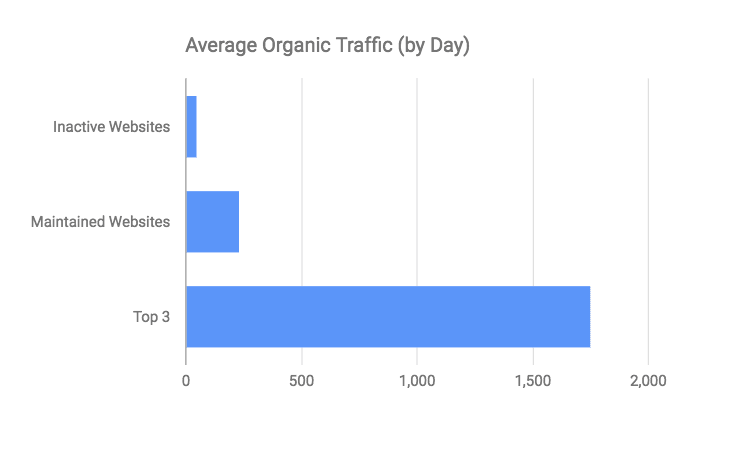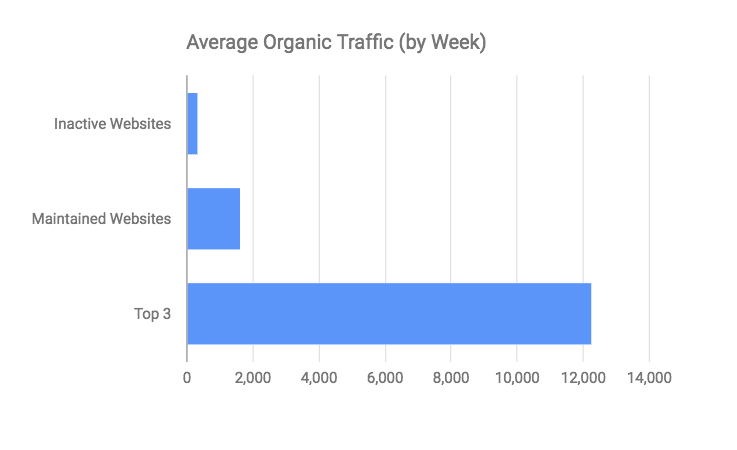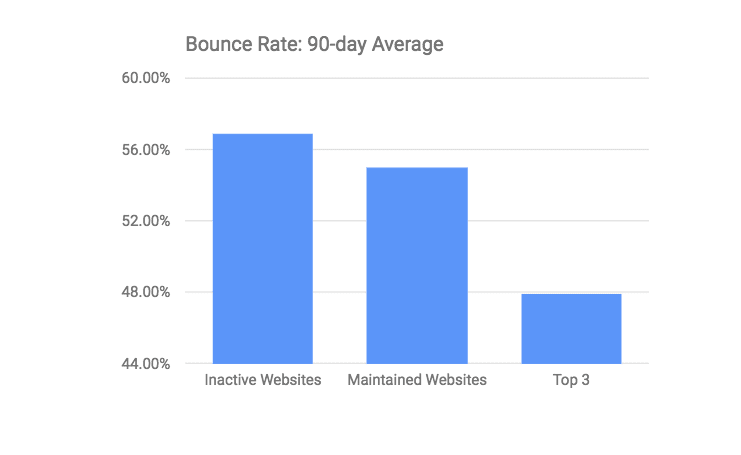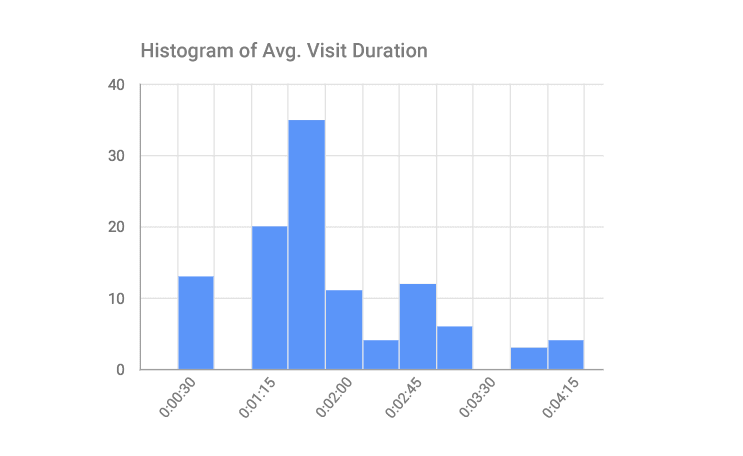An Organic Traffic Analysis of 100 B2B Tech Websites: Part 1
May 3, 2017

Summary: On the surface it's apparent that well maintained B2B websites have the ability to generate more traffic from search engines. It also appears that website visitors prefer the well maintained sites as they tend to stay for longer periods of time and interact with the website more.
Last month while having a conversation with Ryan Nicholson, our VP of Marketing, we realized that several clients had recently asked how the performance of their websites compared to that of their peers. TSL is in a unique position to answer this question for a few reasons.
Let me explain.
TSL offers B2B marketing and lead generation services to technology & non-technology based companies. On the digital side that always includes measuring performance with an analytics platform. Many companies will choose Google Analytics since it's free and capable. Therefore we have access to over a hundred Google Analytics accounts. Because of this, a goal of ours was to create a singular view of all 100 accounts. This was possible using Google Sheets.
What we did
To arrive at the results below we collected the data using the Google Analytics API. This allows for unsampled data that we can filter as we choose. Here are the filters we applied:
- One filter to only show visits to the domain associated with a given analytics account.
- Another filter for websites receiving between 1,000-100,000 visits within a 30 day period.
- Then one to only show visits originating from organic search - Google, Bing, Yahoo, etc.
- And finally, a filter to remove users who visited a given website 10+ times within 30 days.
After filtering the traffic, we manually grouped the websites. This was done based on how frequently the given website was updated (or how often new content was published).
Understanding the results
Each section below has three divisions.
- "Inactive Websites" represents sites that aren't updated but once or twice a year.
- "Maintained Websites" are those that are regularly updated or have an active blog.
- "Top Tier" are a few top performing websites across the analytics accounts we have access to. We separated them so they don't influence the averages.
We want to share this information so your business will have some insight into how your site compares to other B2B tech websites. Today we'll focus on organic traffic from search engines. If you'd like to see subsequent posts with benchmarks from other sources of traffic, then please leave a message in the comments so we know.
Below are the results.
Avg. Organic Traffic for B2B Tech Websites
Avg. Daily Traffic
| Inactive | Maintained | Top Tier |
|---|---|---|
| 48 sessions | 231 sessions | 1,753 sessions |

Avg. Weekly Traffic
| Inactive | Maintained | Top Tier |
|---|---|---|
| 335 sessions | 1,615 sessions | 12,267 sessions |

Well Maintained B2B Sites Receive More Visitors
It's clear here that, from a search perspective, fresh content is going to generate more traffic than stale content. Don't assume that it's more valuable though. It simply means that more opportunities to generate business are created. But poor content, like a poor salesman, can really hurt your business. That said, the top teir analytics accounts aren't making that mistake and end up with almost 8x more organic traffic on average.
Bounce Rate Comparison for B2B Websites
First, what is bounce rate? Bounces are visits to only a single page. In Google Analytics, a "bounce" occurs when a visitor leaves your website before interacting with the website. For example, if someone clicks on a link to download a file and then leaves the websites they would not be included in your bounce rate. An example of a bounce would be when someone visits a blog post, reads it, and leaves without clicking on anything. So, bounce rate is the percentage of visits that result in a bounce.
| Inactive | Maintained | Top Tier |
|---|---|---|
| 56.89% | 54.99% | 47.95% |

Take Aways
Ideally your bounce rate would be below 50%. But, we recommend measuring bounce rate in relation to other metrics, such as "Avg. Time on Page". For example, a high bounce rate and low time on page is likely a negative correlation for B2B technology companies.
We have to be careful making too many assumptions when discussing bounce rate. If your goal is only too have users visit one page on your website, then you may not have to worry. But again, look at the relationship between bounce rate and another KPI. For example, if you have few goal completions or return visitors and a high bounce rate, then a high bounce rate is definitely a negative metric. However, you can clearly see that the top tier website have a noticible difference in bounce rates.
However, the difference between those sites that are maintained and those that aren't is minimal. It appears as though the same number of vistors will leave.
Average Time on Site for B2B Websites
Over a 90 Day Time Period
| Inactive | Maintained | Top Tier |
|---|---|---|
| 0:01:43 | 0:01:51 | 0:02:53 |

Take Aways
Depending on the website and the length of the web page, B2B tech companies should aim for 2-3 minutes for avg. session duration.
Be certain you review your website specifically. And look at individual pages. For example, if people frequently visit a 1,500 word blog post during their visit, then your avg. visit duration is probably bloated. Time is valuable to everyone, especially your prospects. So if they remain on your site then you're hopefully providing value.
As you can see, our Top Tier clients keep visitors for a full minute longer. Recent and relevant content and a well maintained site usually delivers more value. And that's also true for sites that are cared for, as their visitors tend to remain on the site for almost 10 seconds longer.
To keep visitors on your site you can also:
- Engage visitors with your content and images
- Provide clear navigation options to keep them moving through your site
- Create micro-conversion opportunities on each page to measure performance better
- Offer free, un-gated downloads and offers
- Maintain the site so it's the design is simple and fresh
Website Analytics: Why Data is Important
One of my favorite authors, Sir Arthur Conan Doyle once wrote, "It is a capital mistake to theorize before one has data." And then he explains why by saying, "Insensibly one begins to twist facts to suit theories, instead of theories to suit facts."
At least twice a week I hear business owners say that their customers don't use websites. Or they devalue the importance of their brand online. They simply "can't imagine" someone researching a $100K or $1M solution online. Talk about theorizing before having the data, right?
A thriving business or booming sales doesn't equate to a strong brand online, nor does it limit the importance of digital marketing in your marketing plan going forward. Don't insensibly lead your business, as Sir Arthur would say.
Your website analytics should be that data that helps take decisions about the site from the realm of theory to the world of fact. By having a command of these numbers you can start to draw conclusions about your performance versus your competition.
Are you looking for deeper digital insights for your website? Contact us for an introductory session on goal setting and we’ll benchmark your site against other websites in the technology space.
Contact us to start your analytics journey.
Comments